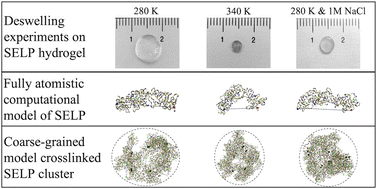Thermo- and ion-responsive silk-elastin-like proteins and their multiscale mechanisms†
Abstract
Silk-elastin-like protein (SELP) is an excellent biocompatible and biodegradable material for hydrogels with tunable properties that can respond to multiple external stimuli. By integrating fully atomistic, replica exchange molecular dynamics simulations with detailed experiments, we predict and measure structural responses to changes in temperature and ion concentration of a novel SELP sequence, as well as a diazonium-coupled version. A single SELP molecule shrinks at high temperatures, whereas diazonium coupling decreases this thermo-responsiveness. Diazonium coupling weakens electrostatic interactions, leading to an insignificant ionic response in the single chain, while also decreasing gelation rates by reducing the number of exposed dityrosine crosslink sites and their solvent-accessible surface areas. With further data from our coarse-grained crosslinked SELP model and our experiments, we find that three effects are critical for SELP cluster's physical response to external stimuli: (1) the structural transition of SELPs at high temperature, (2) the geometry restraints in hydrogel networks, and (3) the electrostatic interactions between molecules. This molecular understanding of the thermal and ion response in single molecules of SELPs and their crosslinked networks may further improve and help innovate SELP's stimuli-responsive properties, creating significant opportunities for applications in biomedical devices and other engineering applications.



 Please wait while we load your content...
Please wait while we load your content...